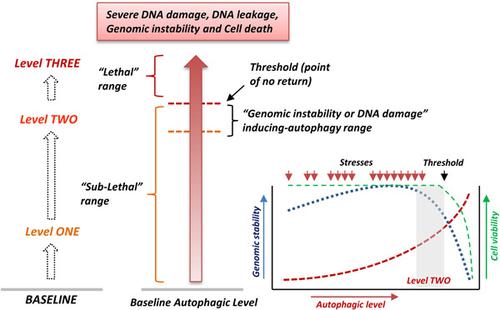当前位置:
X-MOL 学术
›
J. Cell. Physiol.
›
论文详情
Our official English website, www.x-mol.net, welcomes your
feedback! (Note: you will need to create a separate account there.)
The “Dark Side” of autophagy on the maintenance of genome stability: Does it really exist during excessive activation?
Journal of Cellular Physiology ( IF 4.5 ) Pub Date : 2021-08-18 , DOI: 10.1002/jcp.30555 Siao Muk Cheng, Min-Chieh Shieh, Tzu-Yu Lin, Chun Hei Antonio Cheung
Journal of Cellular Physiology ( IF 4.5 ) Pub Date : 2021-08-18 , DOI: 10.1002/jcp.30555 Siao Muk Cheng, Min-Chieh Shieh, Tzu-Yu Lin, Chun Hei Antonio Cheung

|
Dysregulation of DNA damage response/repair and genomic instability promote tumorigenesis and the development of various neurological diseases. Autophagy is a dynamic catabolic process used for removing unnecessary or dysfunctional proteins and organelles in cells. Despite the consensus in the field that upregulation of autophagy promotes the initiation of the DNA damage response and assists the process of homologous recombination upon genotoxic stress, a few studies showed that upregulation of autophagy (or excessive autophagy), under certain circumstances, triggers caspase/apoptosis-independent DNA damage and promotes genomic instability in cells. As the cytoprotective and the DNA repairing roles of autophagy have been discussed extensively in different reviews, here, we mainly focus on describing the latest studies which reported the “opposite” roles of autophagy (or excessive autophagy). We will discuss whether the “dark side” (i.e., the opposite/unconventional effect) of autophagy on the maintenance of DNA integrity and genomic stability really does exist in cells and if it does, will it be one of the yet-to-be-identified causes of cancer, in this review.
中文翻译:

自噬对维持基因组稳定性的“黑暗面”:在过度激活过程中真的存在吗?
DNA 损伤反应/修复和基因组不稳定性的失调促进肿瘤发生和各种神经系统疾病的发展。自噬是一种动态分解代谢过程,用于去除细胞中不必要或功能失调的蛋白质和细胞器。尽管该领域的共识是自噬的上调促进 DNA 损伤反应的启动并有助于基因毒性应激下的同源重组过程,但一些研究表明,在某些情况下,自噬的上调(或过度自噬)会触发 caspase/细胞凋亡非依赖性 DNA 损伤并促进细胞中的基因组不稳定性。由于自噬的细胞保护作用和 DNA 修复作用已在不同的评论中广泛讨论,这里,我们主要关注描述自噬(或过度自噬)的“相反”作用的最新研究。我们将讨论自噬对维持 DNA 完整性和基因组稳定性的“黑暗面”(即相反/非常规的影响)是否真的存在于细胞中,如果存在,它是否会成为尚待解决的问题之一? -在本次审查中确定了癌症的原因。
更新日期:2021-08-18
中文翻译:

自噬对维持基因组稳定性的“黑暗面”:在过度激活过程中真的存在吗?
DNA 损伤反应/修复和基因组不稳定性的失调促进肿瘤发生和各种神经系统疾病的发展。自噬是一种动态分解代谢过程,用于去除细胞中不必要或功能失调的蛋白质和细胞器。尽管该领域的共识是自噬的上调促进 DNA 损伤反应的启动并有助于基因毒性应激下的同源重组过程,但一些研究表明,在某些情况下,自噬的上调(或过度自噬)会触发 caspase/细胞凋亡非依赖性 DNA 损伤并促进细胞中的基因组不稳定性。由于自噬的细胞保护作用和 DNA 修复作用已在不同的评论中广泛讨论,这里,我们主要关注描述自噬(或过度自噬)的“相反”作用的最新研究。我们将讨论自噬对维持 DNA 完整性和基因组稳定性的“黑暗面”(即相反/非常规的影响)是否真的存在于细胞中,如果存在,它是否会成为尚待解决的问题之一? -在本次审查中确定了癌症的原因。











































 京公网安备 11010802027423号
京公网安备 11010802027423号